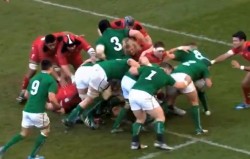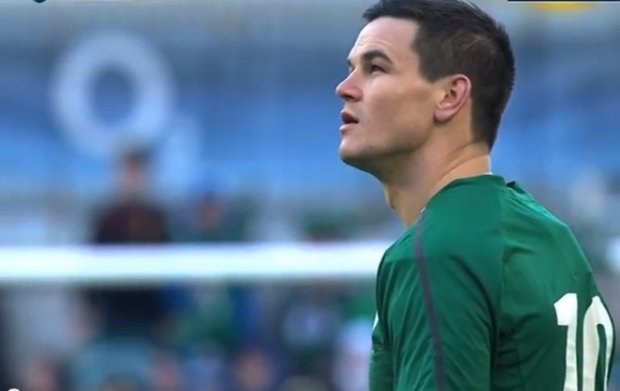Ireland against Wales. A big game with the outcome sure to be in the balance throughout. Both teams strong chances in this Six Nations Championship. Ireland at home, perhaps with a small advantage.
That was the pre-game scenario; but the reality turned out massively different. Ireland completely shut out a strangely lack-lustre Wales, who seemed totally devoid of any ideas.
26 points to 3 is a real shellacking in any language. So complete was Ireland’s domination that Leigh Halfpenny, perhaps currently the world’s most deadly goal-kicker, was given only one shot at goal in the entire match (highlights below).
How was this achieved?
Some specific aspects of Ireland’s play are well worth a close look and budding coaches should look, learn and, importantly, remember.
- As is always necessary, their set-plays were good and their lineout somewhat dominant.
- As suggested above, they had clearly determined not to infringe in their own half. Even with the game wrapped up, in the 65th minute, with Mike Phillips desperate to get his team on top with a quick tap penalty – indeed, a succession of ‘quick taps’ – Chris Henry shunned an enticing (and illegal) tackle and ran back alongside Phillips until he had the legal opportunity. This is not common and showed the determination of his team to deny their opponent any easy points.
- Ireland’s kicking game and their kick chase were both excellent – Rob Kearney and Murray were both stand-outs.
- But, for me, Ireland’s use of the driving maul was the most important factor in their domination. Their selective use of the tactic and their execution were both superb and consistently won them opportunity in both attack and defence.
 They used the maul successfully to get away from their own tryline, to ‘buy’ penalties, to draw defenders, to tire the opposition – mentally & physically, and to score tries!
They used the maul successfully to get away from their own tryline, to ‘buy’ penalties, to draw defenders, to tire the opposition – mentally & physically, and to score tries!
The maul – or maybe I should say, “keeping the ball off the ground” – is a vital, and sadly neglected tactic of our game. The ruck has become the common option at the tackle, even to the extent that ball-carriers frequently seek the refuge of the ground in a ‘voluntary tackle’. Of course, there are many times where the tackler simply ensures that the ball-carrier goes to ground, but, equally, there are many shunned opportunities to continue the attack in a far more meaningful manner.
AND, the ruck is the most easily defended of all, perhaps six, tackle-contest options.
It is the ‘easy’ option. Simply dive on the ground, shove the ball back between your legs and continuity is all but assured. In fact, I wouldn’t even call it ‘continuity’; it is so stop-start, that I see it more as a succession of set plays with ample time for defences to reset before the attack begins anew.
Unfortunately, like most ‘easy options’ in life, it doesn’t achieve much.
Consider:
- The ball-carrier, now on the ground with the ball, is no longer any threat to the defence.
- Defenders can now spread and realign to cover any threats from the reignited attack.
- The role of the attack is to threaten the defence, ideally in such a way as to draw defenders away from their preferred position – for example, an ‘in and out’ line can draw TWO defenders – and to quickly move the ball into the undefended, or lightly defended, area. The ruck negates this opportunity.
- By concentrating a continuous attack close to the tackle zone, the attack can draw larger numbers of defenders to a concentrated area, making space for a subsequent, and immediate, wider attack. Options could be (i) a drive on the ball-carrier, rip and continue forward, (ii) an off-load, (iii) an immediate drive, rip and feed, (iv) a driving mini-maul, peel and continue, (v) a full-blown driving maul.
All are executed with the ball off the ground but, of course, they carry some risk with the ‘use it or lose it’ law, but, without doubt, all quality attack carries some risk at the hands of the defence.
This risk will be minimized by the execution of quality technique under the pressure of whatever game situation presents itself. Regular readers will note my constant reference to the vital need for quality technique and my likewise constant criticism of players and coaches who seem to be happy with sloppy technique. Quality technique underpins ALL quality performance.
Toward the end of the game, with Ireland having subbed a number of first-choice players and with the outstanding backrower, O’Mahoney, forced into the second-row, Ireland scored again from a classic driving maul. One of the commentary team, bless his heart, remarked on this, saying, “Personnel doesn’t matter. Execution is the thing!”
Full marks to Joe Schmidt!
More on this next week.
PS – I will be hosting a river cruise in France in September this year, from the Mediterranean to the Atlantic, via Provence, Burgundy and Paris to Normandy, with an emphasis on food, wine, rugby and the culture of France. I am somewhat experienced in all of these, and would love to see like-minded people join us. Go tohttp://www.cruisescene.com.au/Bob_Dwyer_River_cruise.htm for more details.


